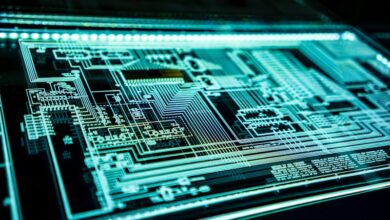What Concepts Does Space Technology Include?

Have you ever wondered what lies beyond the sky? Space, a vast and mysterious expanse, has captivated human curiosity for centuries. But have you ever stopped to think about the technology that enables us to explore this final frontier? In this article, we will delve into the concepts encompassed by space technology.
Space technology encompasses a wide range of disciplines and technologies that enable us to study, explore, and utilize space. One of the key concepts in space technology is rocketry. Rockets serve as the primary means of propelling spacecraft into orbit and beyond. They harness the principles of physics to generate enough thrust to overcome Earth’s gravity and propel vehicles into the depths of space.
Another crucial concept in space technology is satellite technology. Satellites play a pivotal role in our modern world, providing communication, navigation, weather monitoring, and scientific research capabilities. These artificial objects orbiting the Earth transmit signals, collect data, and enable global connectivity, revolutionizing how we communicate and navigate our planet.

Spacecraft technology is another integral aspect of space exploration. These vehicles are designed to transport humans and robotic probes across the vast distances of space. From the iconic Apollo missions to the Mars rovers, spacecraft have allowed us to journey beyond Earth, expanding our understanding of the universe and our place in it.

Additionally, space technology encompasses the field of astrophysics, which involves studying celestial objects and phenomena. Telescopes, both ground-based and space-based, are essential tools in this endeavor. They allow scientists to observe distant galaxies, stars, and planets, unraveling the mysteries of the universe and providing valuable insights into its origins and evolution.
Furthermore, space technology includes the burgeoning field of space tourism. With companies like SpaceX and Blue Origin pioneering reusable rockets and spacecraft, the dream of ordinary individuals venturing into space is becoming a reality. This concept opens up new possibilities for commercial space travel and fosters a future where space exploration is accessible to more than just a select few.
Space technology encompasses a diverse range of concepts that enable us to explore and understand the cosmos. From rocketry and satellite technology to spacecraft and astrophysics, these concepts have propelled humanity beyond the boundaries of our home planet. As we continue to advance in this field, the possibilities for space exploration and discovery are boundless. So, let your imagination soar as we venture into the captivating realm of outer space.
Exploring the Final Frontier: Unveiling the Key Concepts Behind Space Technology
Welcome aboard, fellow space enthusiasts! Today, we embark on a thrilling journey to explore the final frontier and uncover the fascinating world of space technology. From awe-inspiring rockets to cutting-edge satellites, space technology has revolutionized our understanding of the universe and opened doors to new possibilities. So, fasten your seat belts as we delve into the key concepts behind this captivating field.
Space technology is synonymous with innovation, pushing the boundaries of human achievement. One fundamental concept that drives it forward is propulsion. Just like the roaring engines of a powerful car, propulsion systems enable spacecraft to traverse the vastness of space. Whether through traditional chemical rockets or advanced ion thrusters, propulsion is the force propelling us toward the stars.
To navigate the immense cosmos, precise guidance and control systems are crucial. Think of them as the spacecraft’s internal GPS, ensuring accurate positioning and trajectory adjustments. These systems utilize sensors, actuators, and onboard computers to calculate and execute precise maneuvers, allowing us to reach our intended destinations and explore the mysteries of the universe.
Communication is another vital aspect of space technology. Imagine being millions of miles away from Earth, yet still able to connect and relay information. This is made possible by sophisticated communication satellites orbiting above us. These satellites act as cosmic messengers, beaming signals back and forth, facilitating seamless communication between astronauts, mission control centers, and even everyday Earth dwellers.
Spacecraft are not immune to the harsh conditions of the cosmos, which brings us to the next concept: life support systems. These ingenious mechanisms ensure the well-being and survival of astronauts during their ventures beyond our planet. From providing breathable air and maintaining livable temperatures to managing waste and recycling resources, these systems enable extended missions in the unforgiving environment of space.
Lastly, let’s touch upon materials science, an essential discipline in space technology. Spacecraft must withstand extreme conditions, including intense heat during atmospheric reentry and the vacuum of space. Innovative materials such as lightweight composites and specialized alloys are developed to withstand these challenges, guaranteeing the safety and integrity of spacecraft as they voyage through the cosmos.
So there you have it, a glimpse into the captivating world of space technology. From propulsion and guidance systems to communication satellites, life support mechanisms, and materials science, every aspect plays a vital role in unraveling the mysteries of the universe. Fasten your helmets and get ready for an adventure like no other as we continue exploring the final frontier!
The Secrets of the Cosmos Revealed: Understanding the Fundamental Concepts of Space Technology
Have you ever contemplated the mysteries that lie beyond our Earthly boundaries? The vast expanse of the cosmos has long captivated our imagination, and thanks to advancements in space technology, we are beginning to unveil its secrets. In this article, we will delve into the fundamental concepts of space technology that have allowed us to explore and understand the cosmos like never before.
One of the key pillars of space technology is rocket propulsion. Imagine a rocket as a powerful vehicle hurtling through the void of space. It relies on the principle of action and reaction, famously stated by Newton’s third law of motion. By expelling high-speed propellant gases through a nozzle, the rocket generates an equal and opposite force that propels it forward. This ingenious concept enables us to overcome Earth’s gravity, venture into space, and reach distant celestial bodies.
Another vital aspect of space exploration is satellite technology. Satellites act as our eyes and ears in space, providing valuable data and enabling various applications. They orbit the Earth, collecting information about weather patterns, mapping terrains, monitoring environmental changes, and facilitating global communication. Just think of them as cosmic observers, silently floating above us, unraveling the secrets of our planet and the universe.
Space telescopes open a whole new dimension for astronomers and astrophysicists. These extraordinary instruments capture light from distant stars, galaxies, and nebulae, allowing us to observe celestial objects with unprecedented clarity. The Hubble Space Telescope, for instance, has revolutionized our understanding of the cosmos by capturing breathtaking images and unraveling mysteries that were once beyond our grasp.
Furthermore, space probes and rovers have provided us with an up-close exploration of other celestial bodies. From the Moon to Mars and beyond, these robotic explorers venture into the unknown, braving harsh environments to expand our knowledge. They send back invaluable data, revealing the geology, atmospheric conditions, and potential for life on these extraterrestrial realms.
Space technology has unlocked the secrets of the cosmos, enabling us to explore and understand our universe in ways previously unimaginable. Through rocket propulsion, satellites, space telescopes, probes, and rovers, we have gained unprecedented insights into celestial bodies and the laws that govern our vast cosmic neighborhood. As we continue to push the boundaries of space exploration, who knows what other enigmatic wonders await us in the infinite expanse of the cosmos?
From Rockets to Satellites: Delving into the Core Principles of Space Technology
Have you ever wondered how we explore the vast expanse of space? It all begins with rockets and satellites, two key components of space technology that have revolutionized our understanding of the universe. In this article, we will delve into the core principles behind these remarkable inventions and their crucial roles in space exploration.

Rockets serve as the primary means of propelling spacecraft into space. They harness the power of chemical reactions to generate the necessary thrust. Imagine a gigantic firecracker ready to launch into the sky. When ignited, the rocket engines produce an intense burst of energy, pushing against the Earth’s gravity and propelling the spacecraft upwards. With each stage of the rocket burning fuel and shedding weight, it gains the momentum required to break free from Earth’s gravitational pull.
Once in space, satellites take over the reins of exploration. Satellites are essentially high-tech machines designed to orbit the Earth or other celestial bodies. These marvels of engineering enable us to observe our planet, study distant galaxies, and facilitate global communication. Just like the moon orbits around the Earth, satellites follow specific paths, circling our planet at precise altitudes and speeds. Equipped with advanced sensors and instruments, they capture valuable data that scientists analyze to unravel the mysteries of the cosmos.
Space technology relies on intricate systems and meticulous planning. Engineers and scientists work tirelessly to ensure that rockets are precisely engineered, capable of enduring the extreme conditions of space travel. Satellites, too, undergo rigorous testing and calibration before they are launched into orbit. The delicate balance between innovation and reliability is paramount in the world of space technology.
The core principles of space technology encompass various disciplines, including physics, mathematics, and engineering. By applying these principles, we have achieved groundbreaking advancements in space exploration. From launching astronauts into space to beaming images of distant galaxies back to Earth, space technology has enabled us to push the boundaries of human knowledge.
Rockets and satellites are the backbone of space technology, allowing us to venture into the unknown and uncover the secrets of the universe. These awe-inspiring inventions showcase the remarkable ingenuity of human beings and our insatiable curiosity about what lies beyond our planet. As we continue to explore the cosmos, the core principles behind space technology will undoubtedly guide us toward even greater discoveries.
Interstellar Innovations: Unraveling the Cutting-Edge Concepts of Space Technology
Have you ever looked up at the night sky and wondered about the limitless possibilities that lie beyond our planet? The field of space technology has been advancing at an astonishing pace, opening new frontiers for exploration and pushing the boundaries of human knowledge. In this article, we will delve into the captivating world of interstellar innovations, where groundbreaking concepts are taking shape to propel us further into the mysteries of the cosmos.
One of the most intriguing concepts in space technology is the development of reusable rockets. Just like airplanes, these rockets can be launched multiple times, significantly reducing the cost of space missions. Imagine the immense potential of sending payloads and astronauts into space without having to build a new rocket for each mission. This revolutionary approach is paving the way for more frequent and affordable space travel, inspiring both scientists and entrepreneurs to dream even bigger.
Another awe-inspiring innovation is the concept of asteroid mining. Scientists have identified numerous asteroids rich in valuable resources such as precious metals and water. By harnessing advanced robotics and extraction techniques, we could one day harvest these celestial bodies to meet our resource needs here on Earth and even facilitate further space exploration. It’s akin to mining a treasure trove in outer space, unlocking vast opportunities for economic growth and scientific discovery.

Furthermore, the idea of interplanetary colonization has captured the imagination of many. With the advancements in space technology, the possibility of establishing human settlements on other planets, such as Mars, is becoming increasingly realistic. Picture a future where humans venture beyond Earth, forging new civilizations on distant worlds. It’s a journey reminiscent of the great explorers who discovered new lands and changed the course of history, but this time, the frontier lies among the stars.

As we explore these cutting-edge concepts, it is crucial to mention the role of artificial intelligence (AI) in space technology. AI-powered systems are revolutionizing spacecraft navigation, data analysis, and even astronaut assistance. These intelligent machines can adapt to unpredictable situations, making space missions safer and more efficient. Just like a trusted co-pilot, AI is our guiding companion in the vastness of space.
Interstellar innovations in space technology are propelling us toward a future where humanity’s reach extends far beyond the confines of Earth. From reusable rockets to asteroid mining, interplanetary colonization, and the integration of AI, our exploration of the cosmos is witnessing unprecedented advancements. With each discovery and breakthrough, we unravel the mysteries of the universe while setting the stage for extraordinary possibilities that will shape the destiny of humankind for generations to come. The final frontier awaits, and our journey into the stars has only just begun.




